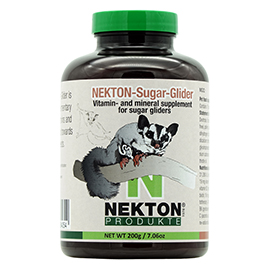Sugar Gliders
NEKTON-SUGAR-GLIDER Food Supplement
 NEKTON-Sugar-Glider is a specially formulated food, enriched with essential vitamins and minerals, specifically designed to meet the unique dietary needs of sugar gliders. Maintaining a balanced diet is crucial for their well-being.
NEKTON-Sugar-Glider is a specially formulated food, enriched with essential vitamins and minerals, specifically designed to meet the unique dietary needs of sugar gliders. Maintaining a balanced diet is crucial for their well-being.
Providing a balanced diet can be challenging since sugar gliders tend to be selective eaters. They often develop preferences for certain foods, which can change from day to day, leaving other options ignored. Despite your best efforts, ensuring your sugar glider receives the necessary nutrients can become a guessing game.
To address this issue, NEKTON has developed a dedicated supplemental food for sugar gliders.
The sugar glider (Petaurus breviceps) is a small marsupial that inhabits trees and originates from Indonesia, New Guinea, New Zealand, and Australia. In the wild, sugar gliders primarily reside in forest areas dominated by eucalyptus and rubber trees.
Adult sugar gliders are about the size of southern flying squirrels, measuring approximately 10 cm (4-inches) from the nose to the end of the tail. They possess a gliding membrane (patagium) that stretches from their front paws to their ankles, enabling them to glide effortlessly from one tree to another. Imported adult sugar gliders generally have a brown coloring, likely influenced by their diet and the color of the trees they inhabit. Their furry tail serves multiple purposes, acting as both a gripping tool and a rudder during flight.
Sugar Gliders as Pets
Before deciding to have a sugar glider as a pet, there are a few important considerations. Sugar gliders are nocturnal animals and can be picky eaters. They can live up to 15 years in captivity and are generally very sociable creatures. With proper care and attention, they can bring many hours of joy.
Creating the Ideal Cage Environment
The cage for a sugar glider should be as spacious and tall as possible, as they enjoy climbing. Provide them with freshly cut branches from non-toxic trees and shrubs like willow, aspen, or apple for climbing. Replace the branches with fresh ones as they dry out. Sugar gliders also appreciate various parrot toys such as ladders, ropes, and rings for exercise.
Inside the cage, set up a small resting platform, a nesting box, and sleeping bags. Place these items in the upper third of the cage since sugar gliders prefer resting in higher areas. Spread small animal bedding or non-toxic leaves and grass without chemical additives on the cage floor to allow the sugar glider to build a nest. Maintain a room temperature between 23 and 29 degrees Celsius (73.4-84.2 °F), with humidity levels typical of a house.
Select a quiet location for the cage to avoid disturbing the sugar gliders with household noises and people passing by during the day.
Recommended Diet for Sugar Gliders
In the wild, sugar gliders primarily feed on nectar, pollen, fruits, juice, buds, berries, and small insects. Their rapid metabolism explains their name "sugar glider" due to the high sugar content in their diet.
As pets, their diet should consist of at least 15-25% animal protein and 75% plant components. Offer them a varied mix of fruits and vegetables, avoiding citrus fruits and excessive amounts of the same fruit. A small amount of hard-boiled egg yolk, premium wet cat food, a few sunflower seeds, and soft seeds can be included. Nuts are a favorite of sugar gliders but should be given in moderation, such as one nut per day, to prevent obesity.
Feed sugar gliders in the late afternoon or early evening, as that's when they prefer to eat. Removing any uneaten fruit in the morning helps reduce fruit fly presence. A diet solely composed of dry feed is not recommended, especially for pet owners with irregular working hours or who are away for a day or two.
Providing a balanced diet can be challenging, as sugar gliders tend to be selective eaters. They often develop preferences for specific foods, which can change from day to day, disregarding everything else. Your efforts to supply a balanced diet may go in vain, and selecting important nutritional supplements can become guesswork.
NEKTON-Sugar-Glider - The Ideal Supplement
That's where NEKTON-Sugar-Glider comes in. It is a specially formulated supplementary feed designed specifically for sugar gliders. Incorporate NEKTON-Sugar-Glider into their diet two to three times a week as an alternative to their regular food.
NEKTON-Sugar-Glider ensures that your pet receives all essential vitamins, minerals, proteins, and carbohydrates needed for their well-being. It's the perfect product to keep your sugar glider healthy and happy.
How to feed:
1g (= 1 measuring spoon included in bottle) in 10 ml (third of an ounce) of lukewarm water, stirring to dissolve. 2 - 3 times a week as a supplement.
Storage:
NEKTON-Sugar-Glider should be stored dry and out of sunlight, between 15° and 25° C (59° and 77° F).
DO NOT STORE IN THE FRIDGE !!!
Composition:
Dextrose, Fructose, Soy Protein Isolate (GMO-free), Precooked Rice, Sucrose, Soy (GMO-free), Pollen, Fine Bakery Products, Dicalcium Phosphate, Sodium Chloride, Calcium Carbonate, Potassium Dihydrogen Phosphate, Calcium Gluconate, Safflower Oil, Magnesium Carbonate, Potassium Chloride, Calcium Glycerophosphate.
Technological additive:
Sorbic Acid, Silicic Acid.
Nutritional additives per kg (2.2lbs):
31,280 IU Vitamin A, 1,578 IU Vitamin D3, 19 mg Vitamin B1 (Thiamine Mononitrate), 21 mg Vitamin B2 (Riboflavin), 32 mg Vitamin E (all rac-alpha-Tocopheryl Acetate), 7,185 mcg Biotin, 16 mg Calcium-D-Pantothenate, 47 mg Niacinamide, 13.7 mg Vitamin B6 (Pyridoxine Hydrochloride), 158 mg Vitamin C (L-Ascorbic Acid), 6.3 mg Vitamin K3 (Menadione Sodium Bisulfite), 1,850 mcg Vitamin B12 (Cyanocobalamin), 1 mg Folic Acid, 78 mg Choline Chloride, 31 mg Iron (Iron(II) Sulfate, Monohydrate), 8 mg Copper (Copper(II) Sulfate, Pentahydrate), 7 mg Manganese (Manganese(II) Sulfate, Monohydrate), 4.6 mg Zinc (Zinc Sulfate, Monohydrate).
Available in 2 sizes: 100g (3.53oz), 200g (7.05oz).


